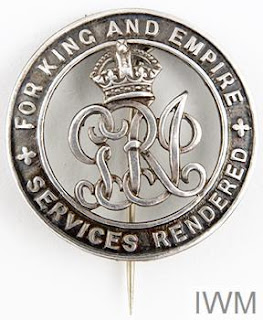Following on from my post last week about caring for the wounded at the field hospital in Étaples where, in the main, most of the soldiers were patched up and sent back to the Western front to continue their military service. However, some were too badly injured to return to duty and so were considered to be medically unfit and were discharged from active service.
The Silver War Badge was issued in the United Kingdom and the British Empire to those service personnel who had been retired or honourably discharged due to wounds, sickness or on reaching the age of 51. It was first issued in 1916 and continued until 1920.
Silver War Badge
 |
| © IWM (INS 7364) |
This small silver pin was designed to be worn on the lapel of civilian clothes after an authorised discharge from the British Army and was first issued in September 1916, but was also retrospectively issued to August, 1914.
It was also known as the ’Silver Wound Badge’, ‘Services Rendered Badge’, ‘Discharged Soldiers Badge’, or ‘King’s Silver Badge’.
The main purpose of the badge was to offer protection to men in uniform so that they wouldn't be considered to be shirkers or objectors. It was evidence that they had been on active service and were now discharged.
Approximately 1,150,000 were issued.
There was also a King's Certificate of Discharge which was awarded to those soldiers who had been disabled by injuries sustained in areas of active fighting overseas. Being awarded a Silver War Badge did not necessarily entitle a soldier to to be awarded the King's Certificate.
~***~


Oh, I didn't know about this badge, what a brilliant idea it was !
ReplyDeleteIt was a lovely idea, Dawn. I've never seen one but will be on the look out for one !
Delete